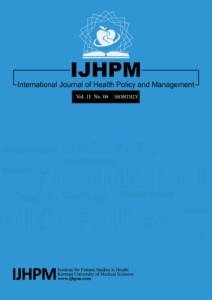Economic Inequality in Presenting Vision in Shahroud, Iran: Two Decomposition Methods
Authors
Mansouri A 1; Emamian MH2 ; Zeraati H3 ; Hashemi H4 ; Fotouhi A5
Affiliations
1 Department of Epidemiology and Biostatistics, School of Public Health, Tehran University of Medical Sciences, Tehran, Iran
2 Ophthalmic Epidemiology Research Center, Shahroud University of Medical Sciences, Shahroud, Iran
3 Noor Ophthalmology Research Center, Noor Eye Hospital, Tehran, Iran
Abstract
Visual acuity, like many other health-related problems, does not have an equal distribution in terms of socio-economic factors. We conducted this study to estimate and decompose economic inequality in presenting visual acuity using two methods and to compare their results in a population aged 40-64 years in Shahroud, Iran.
Methods: The data of 5188 participants in the first phase of the Shahroud Cohort Eye Study, performed in 2009, were used for this study. Our outcome variable was presenting vision acuity (PVA) that was measured using LogMAR (logarithm of the minimum angle of resolution). The living standard variable used for estimation of inequality was the economic status and was constructed by principal component analysis on home assets. Inequality indices were concentration index and the gap between low and high economic groups. We decomposed these indices by the concentration index and BlinderOaxaca decomposition approaches respectively and compared the results.
Results
The concentration index of PVA was -0.245 (95% CI: -0.278, -0.212). The PVA gap between groups with a high and low economic status was 0.0705 and was in favor of the high economic group. Education, economic status, and age were the most important contributors of inequality in both concentration index and Blinder-Oaxaca decomposition. Percent contribution of these three factors in the concentration index and Blinder-Oaxaca decomposition was 41.1% vs. 43.4%, 25.4% vs. 19.1% and 15.2% vs. 16.2%, respectively. Other factors including gender, marital status, employment status and diabetes had minor contributions.
Conclusion
This study showed that individuals with poorer visual acuity were more concentrated among people with a lower economic status. The main contributors of this inequality were similar in concentration index and Blinder-Oaxaca decomposition. So, it can be concluded that setting appropriate interventions to promote the literacy and income level in people with low economic status, formulating policies to address economic problems in the elderly, and paying more attention to their vision problems can help to alleviate economic inequality in visual acuity.
Keywords
Blinder-Oaxaca Decomposition, Concentration Index, Inequality, Iran, Presenting Visual Acuity

